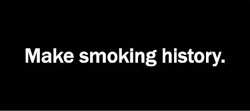The tobacco industry sells products in sweet flavors that appeal to young people.
- Flavored tobacco products are considered “starter” products that aid in the establishment of smoking patterns for youth and can lead to a long-term addiction.[1]
- Federal law prohibits the sale of flavored cigarettes because tobacco companies were marketing flavored cigarettes specifically to minors, who were more likely to have tried these products than older smokers. [2],[3]
- Tobacco companies are using the same flavor chemicals found in candy and soft drink products such as Life Savers, Jolly Ranchers, and Kool Aid to flavor their cigars and smokeless tobacco.[4]
Spread the word. Many people think the tobacco problem is solved. It’s not. The youth cigarette smoking rate continues to decrease in Massachusetts, but 4,700 young people still become cigarette smokers every year in our state. And young people’s use of other tobacco products has increased.[5] High school students now use tobacco products other than cigarettes at a higher rate than cigarettes.[6] Contact your local Tobacco-Free Community Partnership to learn more about this issue and engage with other community members. Tobacco-Free Community Partnership programs work to reduce the tobacco industry’s influence in towns and cities across Massachusetts.
Support local strategies, such as those that restrict flavored tobacco products from places where youth frequent, like corner stores, and allow their sale solely in adult-only stores, like tobacco shops. The flavored tobacco product restriction is focused on limiting youth exposure to flavored tobacco products. Find out more about flavored tobacco regulations and find out if you have a flavor policy in your community.
Look around and talk to your kids. What’s the tobacco industry up to in your community? Talk with kids in your community about tobacco and ask them what they see. Let them know that flavored tobacco products have nicotine in them and are harmful and addictive!
Engage young people. Encourage young people to join The 84 Movement, MTCP’s youth initiative that empowers young people to make changes in their own communities. They help spread the message that the majority of Massachusetts high school students do not smoke and educate local stakeholders about policy change options. Over 1,200 youth are currently registered with chapters of The 84.
Get Outraged! Campaign
In 2016, the Massachusetts Department of Public Health launched – Get Outraged! – to spread awareness to parents and residents of Massachusetts that Big Tobacco is targeting their kids with products that are sweet, cheap, and easy to get. Check out our campaign resources to learn more.
Campaign Resources:
[1] Food and Drug Administration. “Fact Sheet: Flavored Tobacco Products.” Accessed 2/17/16. http://www.fda.gov/downloads/TobaccoProducts/Labeling/ProductsIngredientsComponents/UCM183215.pdf and U.S. Department of Health and Human Services. 2012. Preventing Tobacco Use Among Youth and Young Adults: A Report of the Surgeon General. Atlanta: U.S. National Center for Chronic Disease Prevention and Health Promotion, Office on Smoking and Health, p. 539, http://www.surgeongeneral.gov/library/reports/ preventing-youth-tobacco-use/full-report.pdf.
[2] Carpenter CM, Wayne GF, Pauly JL, et al. 2005. “New Cigarette Brands with Flavors that Appeal to Youth: Tobacco Marketing Strategies.” Health Affairs. 24(6): 1601–1610.
[3] U.S. Department of Health and Human Services. 2012. Preventing Tobacco Use Among Youth and Young Adults: A Report of the Surgeon General. Atlanta: U.S. National Center for Chronic Disease Prevention and Health Promotion, Office on Smoking and Health, p. 539, http://www.surgeongeneral.gov/library/reports/preventing-youth-tobacco-use/full-report.pdf.
[4] Brown, JE, et al., “Candy Flavorings in Tobacco,” New England Journal of Medicine, DOI: 10.1056/NEJMc1403015, May 7, 2014, http://www.nejm.org/doi/full/10.1056/NEJMc1403015.
[5] New underage daily smoker estimate based on data from U.S. Dept of Health and Human Services (HHS), “Results from the 2012 National Survey on Drug Use and Health,” with the state share of national initiation number based on CDC data on future youth smokers in each state compared to national total. Information accessed June, 2014 from: http://www.tobaccofreekids.org/facts_issues/toll_us/massachusetts
[6] http://www.mass.gov/eohhs/docs/dph/tobacco-control/adolescent-tobacco-use-youth-trends-1993-2009.pdf





